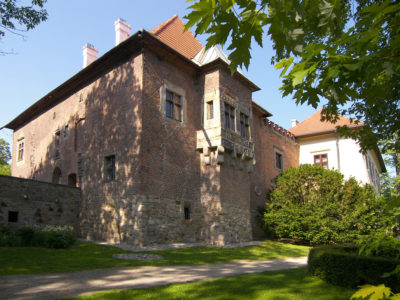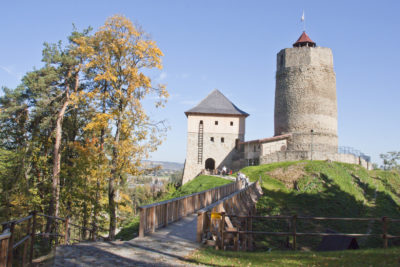
The greatest period of development was during the first half of the 14th century when many noblemen were building strongholds and towns. Today most of those once impressive structures are ruins but some survived becoming significant tourist attractions.
The Dunajec Valley in past centuries cradled an important trail connecting Poland, Hungary and Balkan countries. Consequently in the 13th and 14th centuries several castles were built here. The remaining outlines and ruins of those once impressive structures are being preserved by local communities. People find ancient ruins an important part of their identity and therefore stress local governments to take actions to preserve the remains. Other ‘castle lovers’ act individually and invest private capital. Tropsztyn Castle in Wytrzyszczka was actually rebuild by private investor. Today it is considered to be one of the most beautiful examples of 14th century stone castle in Poland.
CASTLES

The 14th century Castle in Nowy Wiśnicz is the biggest surviving Baroque defensive structure in Poland. It is composed of four two storey wings, grouped around internal courtyard. Castle has a rich architectural and painting decor (marble and stone arches, fireplace settings, wall polychrome and stucco decorations). The feature that allows the Castle its unparalleled allure is the four towers that proudly stand at each of the corners of the residence. Each tower has its own unique shape, rendering the appearance of a completely different structure from every angle. Its current shape is the result of an architectural design by Stanislaw Lubomirski, who had the Castle rebuilt in the years from 1615 to 1621. Since then, the Castle has been rebuilt and has received a stone fortification that now surrounds it.

A local legend tells a story of Stanislaw Lubomirski, a lord who brought many Turkish captives to the Castle of Nowy Wisnicz after winning the battle of Chocim. A few of these prisoners that were confined to a tower began to construct wings from the feathers of the tower pigeons. When the wings were complete, four of the captives decided to fly to their freedom. Unfortunately they did not make it far and the first fugitive crashed in town near the Castle, the second and the third a few kilometers further, and the fourth one crashed near Bochnia. Stone obelisks were placed in each of these locations to commemorate their tragic deaths.

The Debno Castle is a late Gothic style knight’s residence dated sometime between 1470-80, that is the best preserved of its kind in Poland. Unlike similar structures this castle is not surrounded by high walls because it was made in the late Gothic period when there was a shift from an emphasis on protection to prestige demonstrated by structural elevation and comfort. The Castle consists of four two-storey buildings that enclose a cobblestone quadrangle and a well. Wooden galleries within the courtyard allow for a convenient and beautiful passage between castle wings. The brick exterior of the Castle is enhanced with towers, bay windows, and door and window portals that are embellished with inscripted designs (plant, geometrical, and heraldic motifs). The interior exhibitions will offer you both historical facts and the opportunity to experience Thegn Hall, the chapel, the treasury and an old fashion kitchen.

Debno Castle is enchanted by a legend about the tragic love of Tarłówna, the daughter of the master of the Castle, who felt in love with and married her father’s servant. As punishment for the shame of her family and the disobedience of her father’s will, she was bricked up in a wall while still alive. Her ghost, referred to as the “White Lady,” is reportedly haunting the Castle corridors even today.

Tarnow contains the ruins of a castle on Góra św. Marcina (St. Martin Hill). Original structure was erected in the years 1329-1331 by Specimir Leilwita. Originally it was a building made of stone and brick with a large tower, small residential area, and a surrounding rampart. At the beginning of the 16 th century the castle became the residency of Tarnowski family and was thoroughly rebuilt. The new structure composed of a high and low castle both fortified with towers. The castle has slowly deteriorated since the end of the 17 th c.
Bren maintains 17 th century fortifications called “okopy szwedzkie,” or Swedish trenches, which are pentagonal structures built of brick and surrounded by a ditch. The function of such a structure remains unknown.
Dunajec Valley Castles
At one time there was an important trade route that linked Poland, Hungary, and other Balkan countries through the Dunajec Valley. Consequently, many castles were built there in the 13 th and 14 th centuries.
Trzewlin has ruins of a castle built on Panienska Gora (Maiden Mountain) near Wojnicz in the 14 th c. Here there are wall fragments and a ditch still remaining.
Melsztyn contains the ruins of castle of the Leliwici Melsztynscy family, that was founded in 1340. The castle had been renovated in second half of the 16 th century in Renaissance style, but it was destroyed by the Russian army in 1771. Still preserved from the original castle are a fifteenth-century tower with living quarters only partially remaining, the north wall of the palace (16 th c.), and the basement, or water tank.

Czchow is the home of the Czchow Castle ruins, which had been built at the turn of the 14 th century. Currently, it consists of a tower that stretches twenty meters into the air (tourists admitted), the foundations of walls, and living quarters.

Tropsztyn is the castle in Wytrzyszczka that was constructed on a rocky hill in the first half of the 14 th century. It has been thoroughly renovated becoming the most stunning example of a stone castle in Poland. While visiting you can walk along an underground trail that runs through the dungeons, and view an exhibition devoted to the Inca culture. The reason for an Inca display is that legend claims that this castle held the treasure needed for the restoration of the Incas Empire. It was hidden here by offspring of the Inca king.
Gródek nad Dunajcem was a castle built in the beginning of the 15 th century. Its ruins can be seen on the island called “Małpia Wyspa,” or Monkey’s Island, in the northern part of Jezioro Rożnowskie (Roznowskie Lake).
Rożnów contains the remains of the 14 th century Łaziska Castle. Rożnów is also the location of a fortress that was never completed, but only begun by Jan Tarnowski. It consists of three conjoined buildings, a stone pentagonal corner tower and a gate.
Fortified Renaissance Manors
Manor in Wieruszyce was erected in 1531 and renovated in the second half of the 16 th c. The manor is built of stone and rests on a square foundation with a rounded corner tower. It is private property at the present.
Jeżów contains a two-storey mansion built in the first half of the 16 th century, made of stone and brick, and covered with a hipped roof.
Łęki Górne has a brick manor that is dated back to the early 17 th c. It is a three-storey high and loopholes are still preserved in the wall of the staircase.
Szymbark is the home of a manor founded in the 17 th c. and located on the headland of the Ropa Valley.
TOWN FORTIFICATIONS
Biecz is a town once surrounded by impenetrable ramparts and intimidating barbicans during its golden age from the 14 th to the 16 th c. Today a few fragments of Gothic and Renaissance ramparts remain as well as three turrets.
Tarnów is a city that was also greatly protected, surrounding itself with earth walls, ditches, and ramparts in the 14 th century. Fortifications were then modernized in the 15 th and early 16 th c. in order to defend the Church and Monastery of Bernadine that was built in 1468. What is more, the city was enclosed with a double ring of ramparts with towers and apses. Few pieces of the ramparts together with the apse have been preserved to this day. The apse was built of brick; it had composed part of the exterior lower rampart that preceded the main one.
Pilzno received its city rights in 1354. The town’s fortifications, its earth ramparts and apses, were constructed in the 15 th century and then modernized in the 16 th c. The tower and arsenal were again rebuilt in the 19 th century and have remained partially preserved.
FORTIFIED CHURCHES
Gnojnik contains the Gothic church of św. Marcina Biskupa (St. Martin the Bishop) that was founded in 1380. Despite its primary purpose the church was also a defensive structure, evident through the battle stations in the roof top.